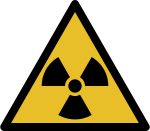El portal de la tecnología nuclear

Construction of the K-25 facility was undertaken by J. A. Jones Construction. At the height of construction, over 25,000 workers were employed on the site. Gaseous diffusion was but one of three enrichment technologies used by the Manhattan Project. Slightly enriched product from the S-50 thermal diffusion plant was fed into the K-25 gaseous diffusion plant. Its product in turn was fed into the Y-12 electromagnetic plant. The enriched uranium was used in the Little Boy atomic bomb used in the atomic bombing of Hiroshima. In 1946, the K-25 gaseous diffusion plant became capable of producing highly enriched product.
After the war, four more gaseous diffusion plants named K-27, K-29, K-31 and K-33 were added to the site. The K-25 site was renamed the Oak Ridge Gaseous Diffusion Plant in 1955. Production of enriched uranium ended in 1964, and gaseous diffusion finally ceased on the site on 27 August 1985. The Oak Ridge Gaseous Diffusion Plant was renamed the Oak Ridge K-25 Site in 1989 and the East Tennessee Technology Park in 1996. Demolition of all five gaseous diffusion plants was completed in February 2017. (Full article...)
Born into a wealthy Polish Jewish family in Lemberg, Austria-Hungary; Ulam studied mathematics at the Lwów Polytechnic Institute, where he earned his PhD in 1933 under the supervision of Kazimierz Kuratowski and Włodzimierz Stożek. In 1935, John von Neumann, whom Ulam had met in Warsaw, invited him to come to the Institute for Advanced Study in Princeton, New Jersey, for a few months. From 1936 to 1939, he spent summers in Poland and academic years at Harvard University in Cambridge, Massachusetts, where he worked to establish important results regarding ergodic theory. On 20 August 1939, he sailed for the United States for the last time with his 17-year-old brother Adam Ulam. He became an assistant professor at the University of Wisconsin–Madison in 1940, and a United States citizen in 1941.
In October 1943, he received an invitation from Hans Bethe to join the Manhattan Project at the secret Los Alamos Laboratory in New Mexico. There, he worked on the hydrodynamic calculations to predict the behavior of the explosive lenses that were needed by an implosion-type weapon. He was assigned to Edward Teller's group, where he worked on Teller's "Super" bomb for Teller and Enrico Fermi. After the war he left to become an associate professor at the University of Southern California, but returned to Los Alamos in 1946 to work on thermonuclear weapons. With the aid of a cadre of female "computers" he found that Teller's "Super" design was unworkable. In January 1951, Ulam and Teller came up with the Teller–Ulam design, which became the basis for all thermonuclear weapons.
Ulam considered the problem of nuclear propulsion of rockets, which was pursued by Project Rover, and proposed, as an alternative to Rover's nuclear thermal rocket, to harness small nuclear explosions for propulsion, which became Project Orion. With Fermi, John Pasta, and Mary Tsingou, Ulam studied the Fermi–Pasta–Ulam–Tsingou problem, which became the inspiration for the field of nonlinear science. He is probably best known for realizing that electronic computers made it practical to apply statistical methods to functions without known solutions, and as computers have developed, the Monte Carlo method has become a common and standard approach to many problems. (Full article...)
Los siguientes proyectos hermanos de la Fundación Wikimedia proporcionan más información sobre este tema: